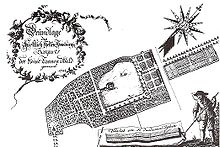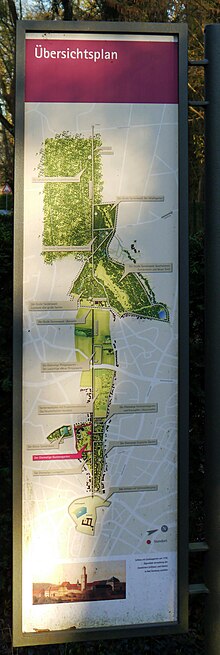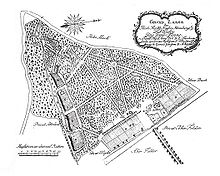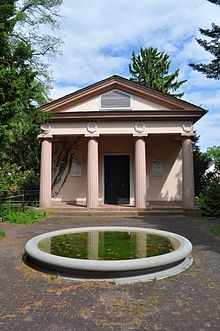Landgravial Gardens Bad Homburg
The Landgravial Gardens were a garden landscape in Bad Homburg , consisting of 14 individual gardens with an area of 385 hectares along the Tannenwaldallee between the Landgrave Castle and the Gothic House .
Initial investment
Landgrave Friedrich V and his wife Caroline began laying out the landgrave gardens in 1770. The landgrave couple was inspired by the English landscape parks . For this purpose, the Bad Homburg Castle Park , which had been laid out in Baroque style a century earlier, was completely redesigned.
Starting from the castle, Friedrich had the Tannenwaldallee , a 2.2-kilometer-long dead straight avenue that merged into the Elisabethenschneise at the edge of the forest , which cut through the Taunus forests to the Roman Limes . This 7.6 kilometer long axis was the basic structure of the landgrave's gardens. The avenue was originally lined with poplar trees. As a counterpart to the southern cypress, these were a symbol of Arcadia . Today the avenue is formed by maple trees in the lower area and chestnut trees in the upper area.
On the edge of the Tannenwaldallee, the "Large Tannenwald" and in 1772 the "Small Tannenwald" were created as individual gardens. At that time, the Taunus (at that time still called "Die Höhe") was largely occupied by beech forests. A fir forest therefore represented an unusual planting.
Final expansion
Under Landgrave Friedrich VI. the project of the landgrave gardens was continued. Friedrich's wife Elisabeth came from England and grew up with English gardening.
In 1823 Friedrich built the Gothic House at the end of the Tannenwaldallee. A total of 14 individual facilities were built on both sides of the avenue: seven gardens in the narrower sense and seven landscaped and forest parks.
In addition to the existing Schlossgarten, Großer and Kleiner Tannenwald grounds, the “Prinzengärten” were laid out: the English Garden, Louisgarten, Gustavsgarten, Ferdinandsgarten and Philippsgarten.
The Kreuzallee , the Heuchelheim hollow field , the Elisabethenschneise landscape park and the four parks belonging to the Great Fir Forest , Lustwald , Buschwiesen , Forstgarten and Hirschgarten formed the landscape parks.
Decay
With the extinction of the Landgrave House in 1866, interest in the park was lost. While the Schlossgarten and Gothic House continued to be used and the Hirschgarten is still a popular excursion destination today, the other grounds became overgrown or (like the Englischer Garten and Louisgarten) were built on in the sixties.
After the Landgrave's death, the Ferdinandsgarten was sold for 3,610 guilders to the gardener GK Merle, who was the tenant of the small fir forest. In September 1881 the Ferdinandsgarten was sold to the Karl Brach in Frankfurt for 40,000 marks (in today's purchasing power 297,516 euros).
In 1932 the area of the small fir forest came into private ownership. In the eighties, a hotel was also planned here. A citizens' initiative , the Small Fir Forest Action Group , was formed, which resulted in the Small Fir Forest becoming a cultural monument in 1988.
reconstruction
Efforts have been made to restore the landgrave's gardens since 1988. In the same year the gardens were designated as a cultural monument. In 2000, the city council decided to restore it. On the basis of this resolution, a garden monument maintenance framework plan was drawn up in 2002. With a cost of 20 million euros, the plant could be rebuilt over a period of 20 years. The aim of the measures is to restore the park according to the plans of 1866.
The "small fir forest"
- Coordinates: 50 ° 13 ′ 41 ″ N , 8 ° 35 ′ 39.7 ″ E
Work has been underway since 2005 to restore the 3.5 hectare "Small Fir Forest". The focus of the first work was the restoration of the 6,600 square meter pond with island and on it the colonnades with 12 Ionic columns. The inauguration took place on July 1, 2007. The next steps were the planting of a hornbeam hedge, the planting of the entrance with oval beds and the restoration of the historical network of paths as well as the ice pit and rose temple.
In 2010 the city of Bad Homburg acquired another part of the small fir forest, on which the ruins of the former Old Switzerland ( cottage ) were. The Förderverein Kleiner Tannenwald supported the purchase, so that this building could be rebuilt in November 2016 with donations and contributions from craft companies.
The restoration of the dairy is planned in the long term . The building, which was newly erected in 1892 after a fire, had run down in recent years, but its substance was already secured in 2005/2006.
Gustavsgarten / Villa Wertheimber
- Coordinates: 50 ° 13 ′ 44.4 " N , 8 ° 35 ′ 42.5" E
The "Gustavsgarten" was laid out by the then Prince Gustav and his wife Louise von Anhalt-Dessau around 1822 on Tannenwaldallee, the size was approximately 6.5 hectares (64,500 m²). Louise grew up in Dessau with the Wörlitzer Park and the couple created a little paradise in which a Doric temple had served as a tea salon since 1830 . The descendants of Gustav and Louise's daughter Caroline Reuss zu Greiz sold the park to the Frankfurt banker Julius Wertheimber around 1898 for 102,000 marks (today's purchasing power 699,577 euros) .
After purchasing part of the Louisgarten , he had the park expanded and laid out as an English landscape park with a considerable variety of plants, the structure of which is well preserved, especially in the northern area. In 1899/1900 the architect Franz van Hoven built a two-storey villa for Wertheimber, the "Villa Wertheimber" and a porter's house at the entrance to the Tannenwaldallee. The villa, the temple and the gatehouse are under monument protection.
A festschrift from 1977 says that the villa “fell to the German Reich” during the Nazi era. According to the current state of knowledge (2015), it was an expropriation or sale under duress. The heirs got the property back in 1947. The building was used during the Third Reich from April 1943 to November 1944 by the Naval Music School (orchestral school) under the direction of the chief musician Otto Romberg. There were only two cohorts in 1943 and 1944, each with 40–50 young sailors. In November 1944 the facility was relocated to Iserlohn . After 1948, the land and the building came to the federal government, which leased it to the "Association for Hirninjury Home". The Frankfurt association built extensions between 1970 and 1980 and operated a neurological clinic there , which closed in 2004.
In the following years, the Tivoli film production company used to film the television series Geld.Macht.Liebe , which was canceled after only one season.
After long negotiations, the park and building were acquired by the city of Bad Homburg in March 2011 for € 7,219,000. It was renovated by the beginning of 2015 and is now used for cultural and other public purposes. The new buildings of the former user, the neurological clinic, were demolished in July 2013. Gustavsgarten has been open to the public again since May 2012. The renovation of the villa's ground floor was completed in spring 2015. The first Bad Homburg Choir Festival took place here as the first cultural event. This choir festival is now to take place every year in the Gustavsgarten. In July 2017, the city archive moved into the Villa Wertheimber, which was previously located in the Gothic House .
Forest garden
In the "forest garden" clearing work was carried out in order to counter the consequences of the heavy wilderness. The larger of the two original ponds was rebuilt and the historic tea house was reconstructed. The next steps are to rebuild the six historic stone bridges and create the small pond.
Deer garden
- Coordinates: 50 ° 14 ′ 11.7 " N , 8 ° 33 ′ 34.8" E
- Main article Hirschgarten (Dornholzhausen)
The "deer garden" in the Dornholzhausen district was the only one of the facilities to have survived. The garden was built in 1698 by Landgrave Friedrich II . The game reserve was in 1820 by Friedrich VI. set up. From 1840 to 1873 the enclosure was leased to hunters by the Bad Homburg casino . Today the Hirschgarten - as the final stop of bus lines 1 and 11 easily accessible by public transport - is a popular local recreation area for Bad Homburg and the Rhine-Main area . The eponymous enclosure includes a number of deer species as well as goats. In addition to a mini golf course , the HirschGarten restaurant is a particular destination for many visitors. The restaurant building was built in 1966 and initially housed a Bohemian venison specialty restaurant. It was renovated in 2000 and is now run by a restaurateur from Bad Homburg. A few hundred meters below the road to the Hirschgarten there is also an open forest clearing, the bush meadows , which is released for barbecuing. The Forellengut with its associated restaurant is also within walking distance .
Ferdinand's Garden
- Coordinates: 50 ° 13 '53.7 " N , 8 ° 35' 39.9" E
On his 40th birthday on April 26, 1823, Ferdinand von Hessen-Homburg received from his brother Friedrich VI. and his wife Elisabeth a piece of land to plant their own garden. The cost of this land was 2914 guilders. The donation was staggered. For five years Ferdinand received an additional piece of land at a time; in the end the size was about two hectares on the Tannenwaldallee. However, Ferdinand was not a great gardener, his passion was hunting. He therefore had the Ferdinand's garden planted with spruce trees and is said to have enjoyed the walks in this forest. After Ferdinand's death, the court gardener Georg Karl Merle acquired the Ferdinand's garden in 1867 and leased the area to his brother, who opened a café there. The son of Georg Karl Merle, Adolph Merle, opened a tree nursery on the site in 1891, which his descendants ran until 1974. In 1974 Leo Peselmann acquired the business, today's Peselmann tree nursery.
See also
swell
- Information board at the small fir forest
- Friedhelm Blume, Elzbieta Dybowska: The Landgrave's garden landscape Bad Homburg in front of the height - restoration of a garden monument. In: Yearbook of the Hochtaunuskreis 2008. ISBN 978-3-7973-1049-1 , pp. 125–132.
- The pearl of the Homburg Park and extreme past: Between the 'Remmidemmi-Hotel' and an idyllic gem. In: Taunus Zeitung. July 2, 2007, p. 24.
Web links
Individual evidence
- ^ Heinz Grosche: History of the City of Bad Homburg. Volume III: The Imperial Era. 1986, ISBN 3-7829-0334-X , p. 25.
- ↑ bad-homburg.de
- ↑ bad-homburg.de
- ^ Heinz Grosche: History of the City of Bad Homburg. Volume III: The Imperial Era. 1986, ISBN 3-7829-0334-X , p. 28.
- ^ State Office for the Preservation of Monuments Hesse (ed.): Villa, gatehouse and park, Tannenwaldalle 50 In: DenkXweb, online edition of cultural monuments in Hesse
- ↑ De luxe television shoot. In: Frankfurter Rundschau. June 19, 2009 (fr-online.de) ( Memento from March 4, 2016 in the Internet Archive )
- ^ Landgravial garden landscape on the website of the city of Bad Homburg
- ↑ Klaus Stöckel: My encounter with military music - the NVA military music school 1975–1990. Books on Demand, 2016, ISBN 978-3-7392-2995-9 , p. 1938.
- ^ Chic villa: Bad Homburg buys Gustavsgarten. In: Frankfurter Rundschau. March 9, 2011. (fr-online.de) ( Memento from February 24, 2016 in the Internet Archive )
- ↑ Representative rooms in Gustavsgarten. In: Frankfurter Rundschau. May 19, 2015. (fr-online.de)
- ↑ Press release of the city of Bad Homburg from May 19, 2015 on the city website
- ↑ The villa is kissed awake by the music. In: Taunus Zeitung. June 2, 2015. (taunus-zeitung.de)
- ↑ 500 meters of shelves full of books. In: Frankfurter Rundschau. July 3, 2017. (fr.de)
- ↑ Gerta Walsh: The prince as a forester. In: Taunuszeitung. August 6, 2016, p. 12.
- ↑ History of nursery Peselmann











